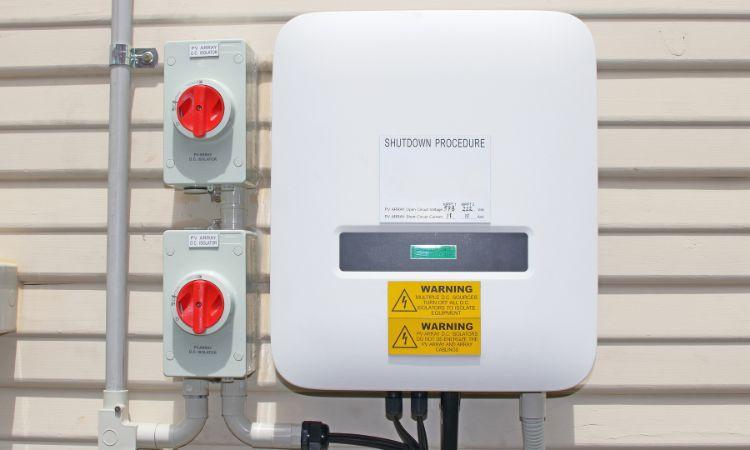The global string inverter market size attained a value of more than USD 3.4 billion in 2023. The market is further expected to grow at a CAGR of 8.9% in the forecast period of 2024-2032, to account for a value of over USD 5.7 billion by 2032. This significant growth underscores the increasing popularity of string inverters in the solar power industry. String inverters play a pivotal role in solar energy systems, converting direct current (DC) generated by solar panels into usable alternating current (AC) electricity for homes, businesses, and the grid.
In this blog post, we will delve into the world of string inverters, exploring their key features, and most importantly, their advantages in solar power systems. Whether you’re a solar enthusiast, a homeowner considering solar installation, or a professional in the renewable energy sector, understanding the benefits of string inverters is crucial. So, let’s dive in and discover why string inverters have become the go-to choice for many solar installations.
Key Features of String Inverters
Before we explore the advantages of string inverters, let’s first get familiar with their key features:
A. How String Inverters Work
String inverters are at the heart of solar power systems. They are responsible for converting the DC electricity generated by solar panels into AC electricity that can be used to power homes and businesses. This conversion is essential because most electrical appliances and the grid operate on AC power. String inverters achieve this transformation through a complex process involving power electronics.
B. Main Components
String inverters consist of several components, including:
-
DC Input: This is where the DC electricity generated by the solar panels is fed into the inverter.
-
DC-AC Conversion Stage: The inverter converts the DC power into AC power through a series of semiconductor devices.
-
Maximum Power Point Tracking (MPPT): String inverters often employ MPPT technology to optimize the power output of solar panels by tracking the point at which they generate the most electricity.
-
Cooling System: To maintain optimal operating temperatures, string inverters are equipped with cooling systems, such as fans or heat sinks.
-
Grid Connection: The AC output from the inverter is connected to the electrical grid or used to power local loads.
C. Inverter Efficiency
Inverter efficiency is a critical factor in the performance of a solar power system. It refers to how effectively the inverter converts DC power into AC power. String inverters are known for their high efficiency, which ensures minimal energy losses during the conversion process. This efficiency directly impacts the overall energy yield of the solar system.
Now that we have a basic understanding of string inverters and their key features, let’s dive into the advantages they offer in the realm of solar power systems.
Advantages of String Inverters
A. Improved Efficiency
One of the standout advantages of string inverters is their improved efficiency compared to other inverter types. Efficiency in this context refers to the ratio of AC power output to DC power input. String inverters typically have high conversion efficiencies, often exceeding 95%. This means that they waste very little energy during the conversion process.
The significance of high efficiency cannot be overstated. When your solar system operates with an efficient string inverter, it maximizes the amount of electricity generated by your solar panels. This translates to more power being available for your consumption or sale to the grid, ultimately leading to greater cost savings and a shorter payback period for your solar investment.
Furthermore, high inverter efficiency contributes to a reduction in greenhouse gas emissions. By converting a larger portion of the solar energy into usable electricity, string inverters help reduce reliance on fossil fuels and promote clean energy generation.
B. Cost-Effectiveness
Cost considerations are paramount when planning a solar installation. String inverters offer several cost advantages that make them an attractive choice for both residential and commercial solar projects:
-
Lower Upfront Costs: String inverters are generally more cost-effective than some alternative inverter technologies, such as microinverters. This can lead to substantial savings in the initial investment required for your solar system.
-
Reduced Installation Costs: The installation of string inverters is typically simpler and requires fewer components than other inverter types. This results in lower installation costs, as well as reduced labor and material expenses.
-
Cost Savings in Large-Scale Projects: String inverters are often the preferred choice for utility-scale solar projects due to their cost-effectiveness. The savings realized in large-scale installations can be significant.
The cost-effectiveness of string inverters extends beyond the installation phase. Their robust and reliable design means they have lower maintenance requirements, translating to further long-term cost savings.
C. Durability and Reliability
String inverters are renowned for their durability and reliability, which are essential qualities for any solar power system:
-
Robust Design: String inverters are built to withstand the rigors of outdoor installation. They are often housed in weather-resistant enclosures, protecting them from environmental elements like rain, snow, and extreme temperatures.
-
Longevity: String inverters have a proven track record of longevity, with many units lasting well beyond their warranties. Their robust construction ensures they can endure the challenges of long-term outdoor exposure.
-
Minimal Maintenance: String inverters typically require minimal maintenance. Regular inspections and occasional cleaning of dust or debris are usually sufficient to keep them running optimally.
-
Reliability in Various Environmental Conditions: String inverters are designed to operate reliably in a wide range of environmental conditions, making them suitable for installations in different geographic locations.
These qualities make string inverters a dependable choice for homeowners and businesses seeking a solar power system that will deliver consistent performance over many years.
D. Scalability
String inverters offer scalability, allowing them to adapt to the specific needs of a solar installation. Whether you have a small residential system or a large commercial project, string inverters can be tailored to suit your requirements:
-
Suitable for Both Small and Large Installations: String inverters are versatile and can be used in a variety of solar setups, from small rooftop arrays to expansive solar farms.
-
Flexibility: They provide flexibility when it comes to adding or replacing inverters. If you want to expand your solar capacity in the future, it’s relatively straightforward to integrate additional inverters into the existing system.
-
Modular Design: Many string inverters feature a modular design, allowing for easy replacement of individual components if needed.
This scalability ensures that your solar system can grow with your energy needs, making it a wise long-term investment.
E. Monitoring and Data Analysis
In the age of data-driven decision-making, the ability to monitor and analyze the performance of your solar system is invaluable. String inverters excel in this regard:
-
Real-Time Monitoring: Many string inverters come equipped with advanced monitoring systems that allow you to track the performance of your solar system in real-time. This includes monitoring of AC and DC voltage, current, and power output.
-
Data Analysis: The data collected by these monitoring systems can be analyzed to identify trends, optimize energy production, and troubleshoot any issues that may arise.
-
Performance Insights: Monitoring also provides insights into the health of individual solar panels, making it easier to detect and address any potential problems promptly.
Having access to this data empowers homeowners and solar professionals to make informed decisions about their solar systems, ultimately maximizing energy production and return on investment.
F. Grid Compatibility
String inverters play a crucial role in grid-connected solar systems, ensuring compatibility and stability:
-
Grid Integration: String inverters are designed to seamlessly integrate with the electrical grid. They synchronize the AC output from the solar panels with the grid’s frequency and voltage, allowing excess electricity to be exported to the grid.
-
Stability and Grid Support: String inverters contribute to the stability of the grid by providing reactive power support when needed. This helps maintain the grid’s voltage and frequency within acceptable limits.
-
Grid Interaction: In many regions, solar system owners can benefit from net metering, where excess energy generated by the solar system is credited or sold back to the grid. String inverters facilitate this interaction.
By ensuring reliable and stable grid connectivity, string inverters enable homeowners and businesses to make the most of their solar systems while supporting the overall stability of the electrical grid.
Case Studies
To illustrate the advantages of string inverters in real-world scenarios, let’s take a look at a few case studies where their benefits shine:
Case Study 1: Residential Solar Installation
Imagine a homeowner, Sarah, who decides to install a solar power system on her rooftop. After careful consideration, she opts for string inverters due to their cost-effectiveness and scalability. Here’s how string inverters benefit her:
-
Cost Savings: Sarah saves significantly on the upfront cost of her solar installation, allowing her to allocate her budget to other sustainable home improvements.
-
Reliability: The string inverters prove to be reliable, with minimal maintenance requirements. Sarah enjoys uninterrupted solar power for years to come.
-
Monitoring: Sarah uses the real-time monitoring feature to keep track of her system’s performance. She can easily identify and address any issues that arise, ensuring optimal energy production.
Case Study 2: Commercial Solar Farm
Now, let’s consider a larger-scale project—a commercial solar farm that spans several acres. The project manager, John, chooses string inverters for the following reasons:
-
Scalability: As the solar farm expands over time, John can effortlessly add more string inverters to accommodate the increased capacity. This scalability ensures the solar farm’s continued growth and profitability.
-
Efficiency: The high efficiency of the string inverters ensures that the solar farm maximizes its energy production, resulting in higher revenues from energy sales to the grid.
-
Grid Compatibility: The seamless grid integration of string inverters allows the solar farm to take full advantage of net metering, further boosting its financial returns.
These case studies demonstrate that the advantages of string inverters extend across various scales of solar installations, from residential to commercial projects. Whether you’re looking to power your home with clean energy or invest in a large-scale solar venture, string inverters offer compelling benefits.



